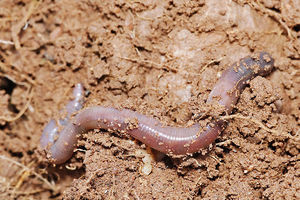Earthworms: Oligochaeta
Physical Characteristics, Behavior And Reproduction, Conservation Status, River Worm (diplocardia Riparia): Species AccountsGEOGRAPHIC RANGE, HABITAT, DIET, EARTHWORMS AND PEOPLE

RIVER WORM (Diplocardia riparia): SPECIES ACCOUNTS
GIPPSLAND GIANT WORM (Megascolides australis): SPECIES ACCOUNTS
Earthworms are found worldwide. They do not occur in deserts, polar regions, or in strongly acid soils. A few species have been widely distributed by humans.
Most earthworms live in the soil, but some prefer the mud along the shores of fresh or salty bodies of water. Depending on species, many earthworms live in the upper leaf litter layer, topsoil, or in deeper layers in the soil. Others live high above the forest floor in soils that accumulate among the branches of tree canopies in tropical rainforests.
Earthworms eat dead and decomposing leaves, decaying roots, and other bits of plant material, or detritus (dih-TRY-tuhs), in the soil. Worms living in leaf litter layer, upper soil, or in soils in tree canopies eat freshly dead plant materials. Other species, such as the European night crawler, always live in deep burrows. They come up to the surface to also eat freshly dead plant tissues. Still other species remain deep in the soil, where they eat long-buried bits of detritus.
Earthworms are very important because they improve and maintain soils, helping plants to grow. Their burrowing activities not only allow air into the soil, but also provide food for growing plants by mixing soil with bits of plant materials. Several species of earthworms are raised to collect their waste for use as a high-quality compost for gardening. Others species are raised and sold as fish bait.
Additional topics
- Leeches: Hirudinea - Physical Characteristics, Habitat, Diet, Behavior And Reproduction, Leeches And People, North American Medicinal Leech (macrobdella Decora): Species Accounts - GEOGRAPHIC RANGE, CONSERVATION STATUS
- Myzostomids: Myzostomida - Physical Characteristics, Behavior And Reproduction, Myzostomids And People, No Common Name (myzostoma Cirriferum): Species Account - GEOGRAPHIC RANGE, HABITAT, DIET, CONSERVATION STATUS
- Earthworms: Oligochaeta - Physical Characteristics
- Earthworms: Oligochaeta - Behavior And Reproduction
- Earthworms: Oligochaeta - Conservation Status
- Earthworms: Oligochaeta - River Worm (diplocardia Riparia): Species Accounts
- Earthworms: Oligochaeta - Gippsland Giant Worm (megascolides Australis): Species Accounts
- Other Free Encyclopedias
Animal Life ResourceMollusks, Crustaceans, and Related Species